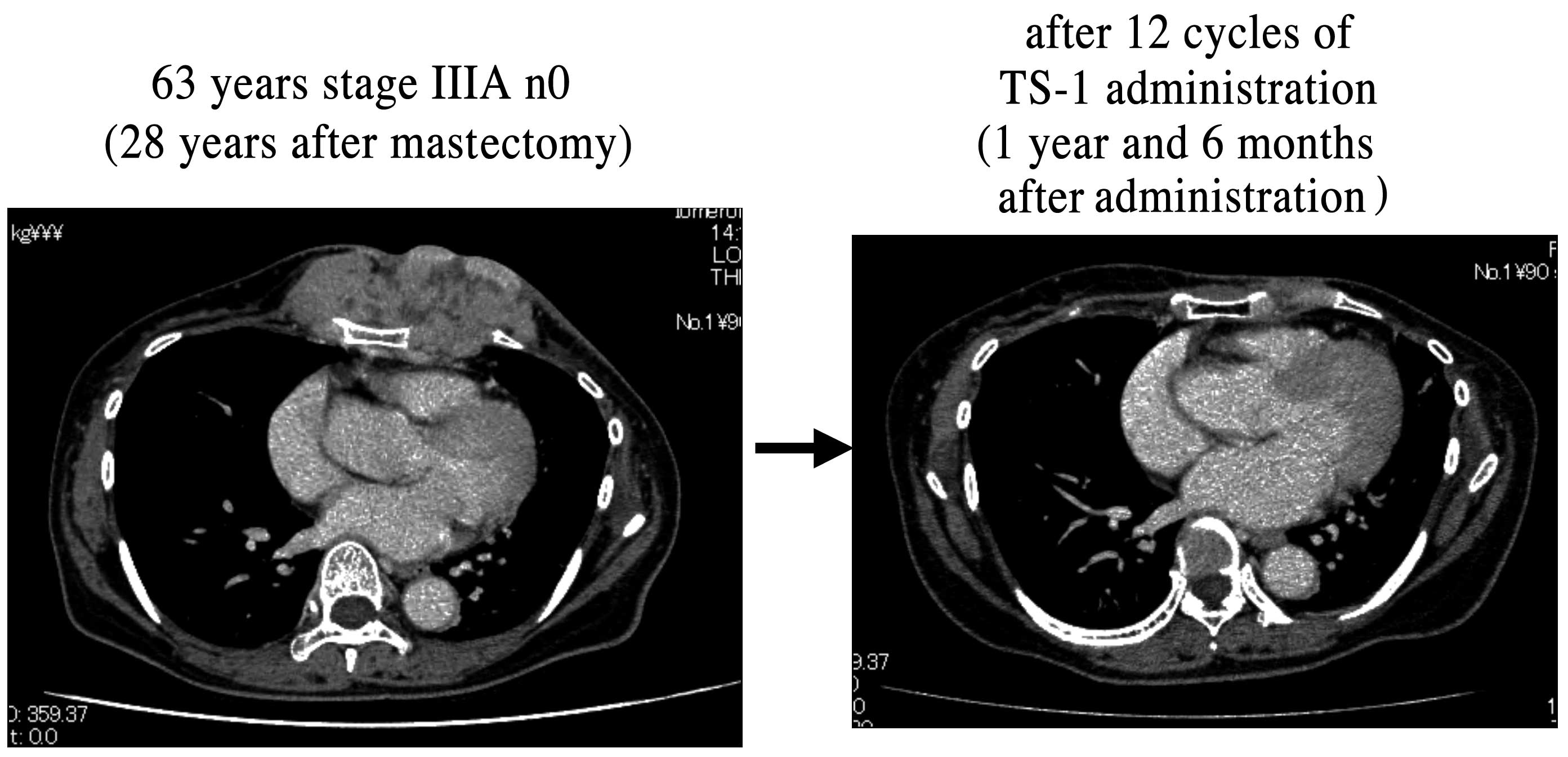Examination of the clinical usefulness of TS-1 in locally recurrent breast cancer
- Authors:
- Takehiro Nohara
- Mitsuhiko Iwamoto
- Kazhuhiro Sumiyoshi
- Satoru Tanaka
- Kosei Kimura
- Yuko Takahashi
- Nobuhiko Tanigawa
View Affiliations
Affiliations: Department of General and Breast and Endocrine Surgery, Osaka Medical College, Osaka, Japan
- Published online on: July 1, 2010 https://doi.org/10.3892/ol_00000117
-
Pages:
669-672
Metrics: Total
Views: 0 (Spandidos Publications: | PMC Statistics: )
Metrics: Total PDF Downloads: 0 (Spandidos Publications: | PMC Statistics: )
This article is mentioned in:
Abstract
This study examined the therapeutic efficacy of TS-1 in the treatment of locally recurrent breast cancer. Between August 2006 and May 2009, 7 patients with local breast cancer recurrences were selected included in the study. The sites of recurrence were the cervical lymph nodes in 4 patients, the axillary lymph nodes in 2 and the thoracic wall in 1. Among the 7 patients, 6 were administered TS-1 as first-line treatment and 1 was administered TS-1 as second-line treatment. Complete response (CR) was achieved in 2 patients, 1 achieved partial response, 2 had stable disease (SD), 1 had long SD and 1 had progressive disease. The overall response rate was 43%, and the clinical benefit rate was 57%. A patient with recurrence of breast cancer in the thoracic wall 28 years after surgery also achieved CR following therapy. The only adverse event observed was a case of hand-foot syndrome in 1 patient. No patients withdrew from treatment, and favorable compliance was achieved in the study. The results indicated that TS-1 has the potential to be one of the drugs for first-line treatment of locally recurrent breast cancer.
View References
|
1
|
Shirasaka T, Shimamoto Y, Kato T, et al:
Invention of a tumor-selective 5-fluorouracil derivative named S-1
by biochemical modulation of 5-fluorouracil. JPN J Cancer
Chemother. 25:371–384. 1998.PubMed/NCBI
|
|
2
|
Saeki T, Takashima S, Sano M, et al: A
late phase II clinical study of S-1 in patients with progressed,
refractory breast cancer. JPN J Cancer Chemother. 31:539–547.
2004.PubMed/NCBI
|
|
3
|
The Japanese Breast Cancer Society. A
Manual For Evidence-Based Clinical Practice Guideline 1 Medication.
Kanehara Shuppan; Tokyo: pp. 91–96. 2007
|
|
4
|
Therasse P, Arbuck SG, Eisenhauer EA, et
al: New guidelines to evaluate the response to treatment in solid
tumors. J Natl Cancer Inst. 92:205–216. 2000. View Article : Google Scholar : PubMed/NCBI
|
|
5
|
Nohara T, Iwamoto M, Sumiyoshi K, et al:
Clinical effect and positioning of capecitabine for metastatic
breast carcinoma. JPN J Cancer Chemother. 35:1315–1318.
2008.PubMed/NCBI
|
|
6
|
William BD: Capecitabine monotherapy; safe
and effective treatment for metastatic breast cancer. Oncologist.
11:325–335. 2006. View Article : Google Scholar : PubMed/NCBI
|
|
7
|
Yoneyama K, Yamada A, Koshida Y, et al: A
patient with pulmonary metastasis from breast cancer after surgery
who responded to S-1. JPN J Cancer Chemother. 34:1143–1162.
2007.PubMed/NCBI
|
|
8
|
Shiiki S, Sonoo H, Seki M, et al:
Therapeutic efficacy of capecitabine on advanced and recurrent
breast cancer with special reference to time to progression. JPN J
Cancer Chemother. 33:1431–1435. 2006.PubMed/NCBI
|
|
9
|
Shigemori C, Mizutani M, Iwata H, et al:
The experience of capecitabine in advanced or reccurent breast
cancer. Nyugan No Rinsyo. 21:148–152. 2006.
|
|
10
|
Hortobagyi GN: Treatment of breast cancer.
N Engl J Med. 339:974–984. 1998. View Article : Google Scholar
|
|
11
|
Greenberg PA, Hortobagyi GN, Smith TL, et
al: Long-term follow up patients with complete remission following
combination chemotherapy for metastatic breast cancer. J Clin
Oncol. 14:2197–2205. 1996.PubMed/NCBI
|










